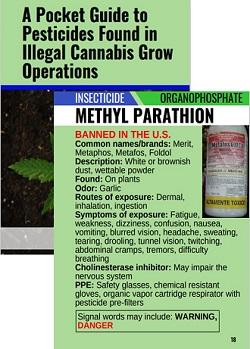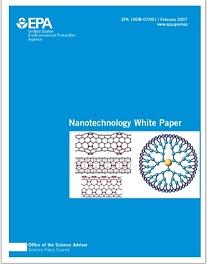
About the BLM Hazardous Material Management Program
The Bureau of Land Management has focused on the long-term management and preservation of the land since its creation in 1946 with the merger of the Grazing Service with the General Land Office. The BLM efforts to balance the use of natural resources with the need to preserve the land for future generations helped serve as a check on the impact of hazardous materials on human health and the environment. The BLM efforts became more focused with the rise of environmental activism in the 1960s and 70s.
However, many issues in using and disposing of hazardous materials predate both the BLM and the rise of environmental consciousness within the U.S. Often the hazards were not understood, or the positive impacts outweighed (or were thought to outweigh) the negative effects at the time. There are numerous examples. Arsenic solutions were used in cattle dip pits from roughly 1915 until 1960 to help eradicate Cattle Tick Fever. Arsenic-based pesticides were used in apple and cherry orchards from the early 1900s and were not phased out until 1960. DDT came into use in the 1940s as an insecticide for use in agriculture and public health antimalarial campaigns. Its use was not restricted in the U.S. until the 1970s and it is still used on a limited basisto control mosquito-borne disease outbreaks. Lead based paints were used for centuries and was not banned in the U.S. until 1977 and only then for use in residential properties, public buildings, toys, and furniture.
The uses of hazardous materials sites became concerns once the knowledge of their health and ecological effects became widely known and as new land uses were considered, or off-site migration of contamination was discovered. Federal and state governments enacted and refined their environmental laws and their associated regulations after the revelations of large-scale environmental disasters of the Cuyahoga River in Ohio, Love Canal in New York, Libby Mine in Montana, and Times Beach in Missouri.
The Federal Land Policy and Management Act (FLPMA) of 1976, which established the current BLM land policies, paralleled the creation of major federal environmental laws. FLPMA incorporated the need to adhere to the rising government involvement in environmental protection as codified in the Clean Water Act (CWA) of 1972; Resource Conservation and Recovery Act (RCRA) of 1976; Toxic Substances Control Act (TSCA) of 1976; and Comprehensive Environmental Response, Compensation, and Liability Act (CERCLA) of 1980. These laws contain most of the statutory considerations for the BLM Hazardous Materials Management (HMM) Program.
Published in 1988, Opportunity and Challenge, The Story of BLM by James Muhn and Hanson R. Stuart describes one of the early BLM remediation projects at the Lee Acres Landfill near Farmington, NM. Located on land leased by BLM to San County, NM, a hydrogen sulfide release at the landfill prompted the closing of the landfill. BLM undertook the lead in the multi-million-dollar environmental response action as one of the responsible parties with CERCLA liability and authority. BLM continues to monitor the site and maintain the controls in place.
Other large BLM sites where hazardous material contamination was discovered includes the Pacific Gas and Electric Topock Compressor Station in California, which also involves the Bureau of Reclamation, US Fish and Wildlife Service, and the Fort Morgan Indian Tribe, and the Metropolitan Water District of Southern California. (Topock is a companion to the Hinkley PG&E compressor station that was the subject
of the Oscar nominated movie Erin Brockovich, which tells the story of similar contamination and its impacts on neighboring communities).
BLM has also received large tracts of land from federal agencies that require special handling and remediation of hazardous material contamination. The bulk of these lands were from the 13 million plus acres of public lands withdrawn for use by the military during World II.
One of the largest releases was codified in FLPMA and created the California Desert Conservation Area which included the 18,000 square-mile World War II Desert Training Center/California–Arizona Maneuver Area. This was once the largest military training maneuver area in the world. The public lands once used for desert warfare training by General George Patton are now managed by the BLM.
The Department of Defense retained the responsibility of investigating and investigating these former military areas, but BLM must work with the DoD in this effort to protect the public. Large tracts of former bombing ranges and gunnery ranges remain to be investigated and hazards mitigated. Explosive hazards remain even within areas such as the California Desert Conservation Area where environmental response actions have been completed. These areas pose continuing challenges for the HMM Program and BLM land managers in protecting the public while allowing use of the land.
The management of hazardous materials is not limited to the known historical contaminated sites. Abandoned disposal sites from former homes, communities, schools, farms, ranches, and commercial and industrial areas are scattered across BLM managed lands. Typically, these sites are not discovered unless the land is redeveloped, or contamination is discovered in streams or public groundwater supplies.
New Challenges
BLM operations and BLM authorized land uses, though monitored and controlled to comply with current regulations, will have the occasional accidental release of a hazardous material. These are reported and dealt with to limit damage to the environment and human health. Of greater concern are the unauthorized uses of BLM lands, which are often accompanied by the use and improper disposal of hazardous materials.
Clandestine drug ventures have become larger with corresponding increases in the chemicals used in their agricultural and manufacturing operations. Ad hoc community and individual use trash dumps are not only eye sores but are also not equipped to handle the wastes from materials in common use today. In some cases, the toxic or hazardous nature of the waste can lead to the dumping of the waste on BLM managed lands to avoid the difficulties and costs of disposal. An example is the three trailer loads of alcohol-based hand sanitizer dumped on BLM lands in Southern California to avoid disposal costs.
The universe of hazardous material continues to expand. Electronic wastes (also known as e-waste, e-scrap, and end of life electronics), such as computers and monitors, contain high levels of contaminants such as lead, mercury, cadmium, and arsenic that may leach into the environment. Per- and polyfluoroalkyl substances (better known as PFAS) is used in a broad range of products that includes clothing, cookware, cosmetics, and firefighting foams. These chemicals were thought to be chemically inert but are now linked to cancer and other health problems. Nanomaterials, once rare and exotic, are entering common use and little research exists on their effects once released into the workplace and the environment.
The HMM Program will continue to adapt to the new challenges and contribute to the BLM mission to mission is to sustain the health, diversity, and productivity of public lands for the use and enjoyment of present and future generations.
Timeline
1812- General Land Office, responsible for all public land sales, patents, and entries, is established within Treasury Department to oversee disposition of ceded and acquired lands.
1934- Taylor Grazing Act authorizes grazing districts, regulation of grazing, and public rangeland improvements in Western states (excluding Alaska) and establishes Division of Grazing (later renamed U.S. Grazing Service) within the Department of the Interior.
1941-1945- World War II. Extensive withdrawal of public lands for military purposes begins, with more than 13 million acres withdrawn in two years.
1945- Post World II base closures begin with some bases reactivated during the Korean and Vietnam conflicts and too support events such as the Mariel Boat Lift.
1946- BLM is established within the Department of the Interior through the consolidation of General Land Office and U.S. Grazing Service.
1949- Federal Property and Administrative Services Act.
1952- Federal Water Pollution Control Act.
1954- Recreation and Public Purposes Act amends the 1926 Act and allows sale and lease of public lands for purposes besides recreation, such as landfills.
1969- Environmental movement begins and the federal government enacts federal law focused on environmental protection. National Environmental Policy Act.
1970- Clean Air Act and Occupational Safety and Health Act. U.S. Environmental Protection Agency established.
1972- Clean Water Act.
1974- Safe Drinking Water Act.




